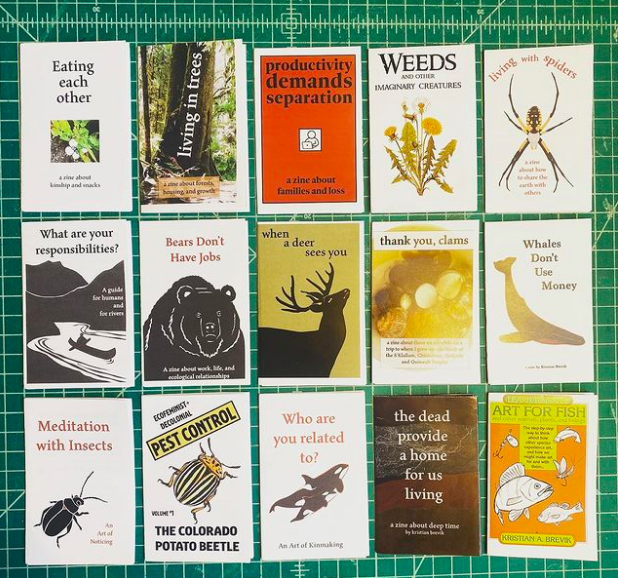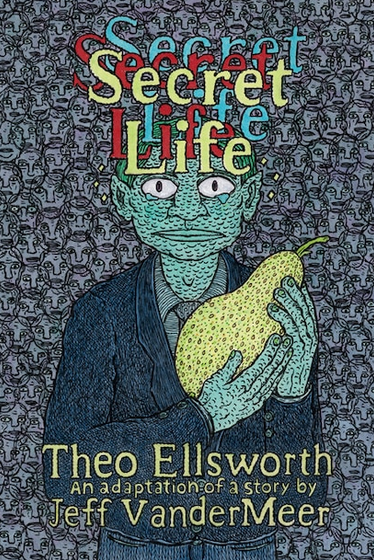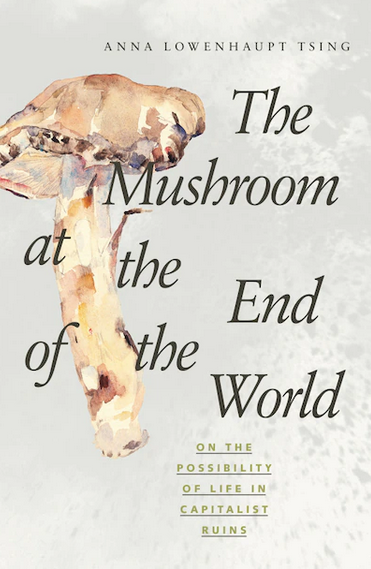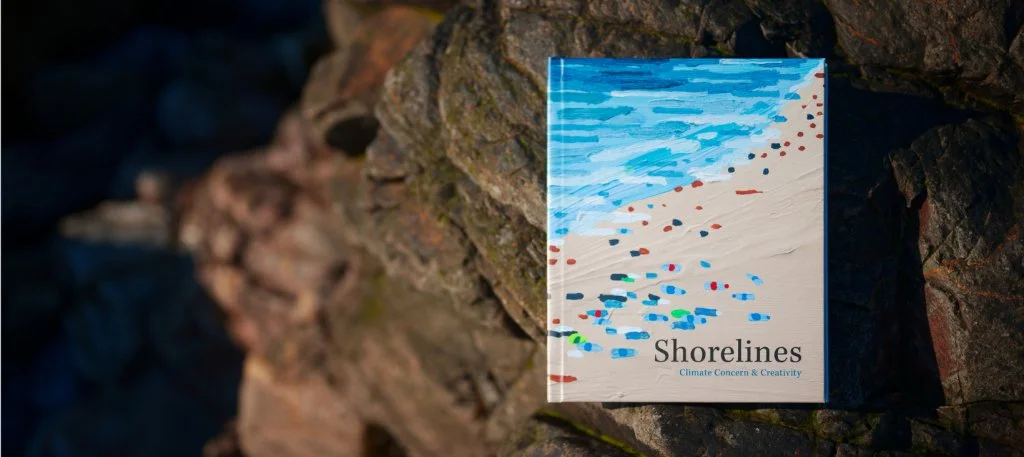This is the seventh installment in a series of blog posts by ClimateSense Intern Alexis Bulman, who is sharing monthly insights into her research, creative process and artistic explorations as she works with us to develop community-engaged artworks and programming around climate change adaptation.
This month's post takes the form of a holiday gift guide- it’s a convenient structure to share 8 resources that have been influencing my artistic Climate Sense research. Before diving into my reading recommendations, I feel the need to highlight the link between global capitalism and the global Climate Crisis, and how the lavish holiday gift-giving season does not help matters. Household waste can increase by more than 25% over the holidays. The majority of nearly half-a-million tonnes of holiday waste that goes to Canadian landfills each year is made up of discarded gift-wrapping, plastic, foil wrapping paper, ribbons, gift bows and toy packaging. (Resource: Recycling Council of BC).
For the last couple of Christmases, I’ve attempted to create less waste by wrapping gifts in brown craft paper and recyclable twine, I’ve given gifts in the form of baked treats, gifts that can be shared for continuous enjoyment (like books) and gifts that have permanence (like art), or I don’t buy gifts at all — instead I’ll plan activities. My four nieces are growing rapidly and their interests change just as quickly, so instead of buying toys and clothing they’ll outgrow, I’ve taken them indoor rock climbing, or planned circus themed baby-sitting days. You can also decide to give donations or volunteer at a local organization. If you must shop avoid Amazon and spend your dollars locally.
The holiday season is also a time of year when we have time off from work to sit around in flannel pajamas and read a book. So without further ado, here are 8 books that prove that reading and learning about the Climate crisis can be leisurely. (Some of these books are light and fun, some will make you cry, some are conceptual and each of them will at least make you reconsider your use of gift bows and scotch tape).
1: Zines by Kristian Brevik
A green grid background with 15 colorful zines evenly spaced in three rows of five
I met Kristian Brevik while both of us were collaborating with the River Clyde Pageant last summer. Brevik’s zines combine his love of art and science, and shares some of the ideas he finds most profound about how we relate to other species. The zines draw from ecofeminism, Indigenous STS, decolonization, anthropology, SF, and more. The zines are small, quick to read, and they share the work of humans whose work is influential to Brevik as he explores kinship and how to live in relationship with the broad community of life and land. So far my personal favorite has been Art for Fish. You can purchase all 15 zines on Etsy for $55.99 or you can support his Patreon with a friend's address, so they can receive the gift of monthly zines in their mailbox!
2. Mourning Nature: Hope at the Heart of Ecological Loss & Grief, Edited by Ashlee Cunsolo & Karen Landman
A book cover deicting a cloudy sky, a horizon of distant mountains and a foreground of an errie gray body of water with drift wood. overtop font reads “Mourning Nature Hope at the Heart of ecological Loss & Grief, edited by Ashlee Cunsolo & karen Landman”
Mourning Nature is a collection of short essays, each one a recognition and expression of grief related to environmental degradation. As a disability-identified artist, I often advocate for art to be shared in inclusive ways, such as art that employs multiple senses (touch, smell, sound, sight, taste..) with the belief that art experienced through multiple senses might evoke a stronger connection with it’s viewers, and be more interpretable by viewers with a wide spectrum of disabilities. So naturally, I was excited to read two essays in this book which explores the loss of wild landscapes through described soundscapes. Essayists Helen Whale and Fraklin Ginn wrote about the absence of sparrows in London, UK, and an essay by Bernie Krause tells an astounding story about an audio recording of a beaver whose habitat was destroyed. Until reading this book, I always thought about the climate crisis through sight and feel (melting glaciers and trying to stay cool during heat waves for example), it never occurred to me that a changing climate also equaled a changing soundscape.
3. The Optimistic Environmentalist by David R. Boyd
A blue book cover with a large whale and a scubba diver. Overtop light blue font reads “ The Optimistic Environmentalist progressing Towards a Greener Future David R. Boyd”
After reading Mourning Nature, The Optimistic Environmentalist just happened to be the next book I picked up, and I strongly recommend reading them in this order! Mourning Nature will open your eyes and fill them with tears, but The Optimistic Environmentalist will give you hope. The book lays out multiple examples of remarkable achievements and success stories, demonstrating what we are capable of when we act together in the face of environmental despair. I didn’t know a book about the climate crisis could be uplifting, but here it is!
4. Secret Life by Theo Ellsworth, an adaptation of a story by Jeff VanderMeer
A heavily illustrated book cover depicts a figure with green bumpy skin holding a piece of yellow fruit and wearing a blue coat. Around the figure in the background is a repeating drawings of faces. Over top front reads “ Secret Life Theo Ellsworth an adaptation of a story by Jeff VanderMeer”
Indulge yourself in this eerie graphic novel by Theo Ellsworth, published by Drawn and Quarterly. I lived in Montreal for a few years and during that time I got really into graphic novels, partly because the Drawn and Quarterly bookstore was located between my Mile End art studio and my apartment in Park Extension so I frequently stopped in. When I saw this new book release I picked up a copy- I’m so happy I did because the black inky drawings of this fiction explores the collision of the natural world and the human-made world, themes which I'd been tackling in my own sketchbook throughout Climate Sense.
5. The Mushroom at the End of the World, On the Possibility of Life in Capitalist Ruins by Anna Lowenhaupt Tsing
A grey book cover with an illustration of a large mushroom on the left. Overtop black and green font reads “Anna Lowenhaupt Tsing the Mushroom at the End of the World on the Possibility of Life in Capitalist Ruins”
The best way to summarize this book is to pull a quote from the back cover, “ Matsutake is the most valuable mushroom in the world—and a weed that grows in human-disturbed forests across the Northern Hemisphere- The Mushroom at the End of the World explores the unexpected corners of matsutake commerce, where we encounter Japanese gourmets, capitalist traders, Hmong jungle fighters, and more.” This book delves into the relationship between capitalist destruction and collaborative survival and it took me on a true adventure at the same time.
6. Shorelines, Climate Concern & Creativity
A photograph of a book atop a rocky surface. The book cover is blue and tan and painterly. Over top black and blue font reads “Shorelines Climate Concern & Creativity”
This might be my favorite book of the bunch!
Shorelines is a compilation of educational and emotional responses to climate concerns of local artists and writers, and it was made in partnership by the Environmental not-for-profit ACAP Saint John and artist-run centre Third Space gallery. The front cover starts this book off on the right foot, with a lushishly painted scene of a shoreline littered with plastic bottles painted by (one of my favorite Canadian painters) Jack Bishop. Open the book and more beautiful examples of empathy and awareness of the climate vulnerabilities facing Saint Johns continue. A short comic strip titled Flood Preparation by Patrick Allaby illustrates his experience with buying his first home in Sackville on an artist's income, in a city that’s in immediate danger of flooding. He opts for a house that’s too small, too expensive, too far from downtown but has the highest elevation.
7. All We Can Save, truth, courage, and solutions for the Climate Crisis, Edited by Ayana Elizabeth Johnson & Katherine K. Wilson
A book cover with a soft yellow background and warmer yellow sun-like illustration. Over top dark blue font reads “All We Can Save Truth, Courage, and Solutions for the Climate Crisis edited by Ayana Elizabeth Johnson & Katherine K. Wilkinson”
This book of essays, art and poems spans 375 pages, each one packed with insights and expertise from dozens of women scientists, journalists, farmers, lawyers, teachers, activists, innovators, designers and more- each working across generations, geographies and races to radically reshape society. I’ve dog-eared and jotted down more notes from this book than any other! A comical and disheartening poem by Ailish Hopper points to the fact that humans have done so much to avoid taking ownership for the Climate Crisis problem. A few lines from her poem:
We buried the problem.
We planted a tree over the problem.
We declined to comment on the problem.
We wrote a law for the problem, but it died in committee.
We marched, leafleted, sang hymns, linked arms with the problem.
We elected an official who Finally Gets the problem.
We mutually empowered the problem.
8. Climate Diary, published by the University of Prince Edward Island
Three open books, one green, one blue and one orange are piled upon one another against a white background. To the right in a black frame is a photo of a black book with the title “Climate Diary”.
Climate Diary is like a scavenger hunt activity book for adults, centered around Phenology: the study of recurring seasonal events in plants and animals and the timing of these events in relation to weather and climate. Published by the University of Prince Edward Island, this book is laid out in such a way that it helps you, the observer, identify and record observations of naturally-occurring plant and animal life cycle events over time in PEI. For example, if you’ve spotted black berries you can turn to page 124 to learn about the common blackberry and record when it flowered, and when the berry ripened. Recording this information on an annual basis will show how climate impacts blackberry seasons over time. There is room in the book to record sightings until 2039, at which point the Climate Diary can be mailed back to UPEI so that data can be collected and compiled from all across the island. This book has made me pay closer attention to the world in my backyard.
The next books on my reading list are: The Legacy, An Elders Vision for our Sustainable Future by David Suzuki, Pollution is Colonialism by Max Liboiron and The Web of Life: A New Scientific Understanding of Living Systems by Fritjof Capra. In a future post I’ll share my thoughts on these books.
Happy holidays and happy learning!








